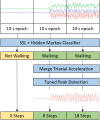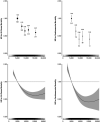This is a preprint.
Development and Validation of a Machine Learning Wrist-worn Step Detection Algorithm with Deployment in the UK Biobank
- PMID: 37205346
- PMCID: PMC10187326
- DOI: 10.1101/2023.02.20.23285750
Development and Validation of a Machine Learning Wrist-worn Step Detection Algorithm with Deployment in the UK Biobank
Abstract
Background: Step count is an intuitive measure of physical activity frequently quantified in a range of health-related studies; however, accurate quantification of step count can be difficult in the free-living environment, with step counting error routinely above 20% in both consumer and research-grade wrist-worn devices. This study aims to describe the development and validation of step count derived from a wrist-worn accelerometer and to assess its association with cardiovascular and all-cause mortality in a large prospective cohort study.
Methods: We developed and externally validated a hybrid step detection model that involves self-supervised machine learning, trained on a new ground truth annotated, free-living step count dataset (OxWalk, n=39, aged 19-81) and tested against other open-source step counting algorithms. This model was applied to ascertain daily step counts from raw wrist-worn accelerometer data of 75,493 UK Biobank participants without a prior history of cardiovascular disease (CVD) or cancer. Cox regression was used to obtain hazard ratios and 95% confidence intervals for the association of daily step count with fatal CVD and all-cause mortality after adjustment for potential confounders.
Findings: The novel step algorithm demonstrated a mean absolute percent error of 12.5% in free-living validation, detecting 98.7% of true steps and substantially outperforming other recent wrist-worn, open-source algorithms. Our data are indicative of an inverse dose-response association, where, for example, taking 6,596 to 8,474 steps per day was associated with a 39% [24-52%] and 27% [16-36%] lower risk of fatal CVD and all-cause mortality, respectively, compared to those taking fewer steps each day.
Interpretation: An accurate measure of step count was ascertained using a machine learning pipeline that demonstrates state-of-the-art accuracy in internal and external validation. The expected associations with CVD and all-cause mortality indicate excellent face validity. This algorithm can be used widely for other studies that have utilised wrist-worn accelerometers and an open-source pipeline is provided to facilitate implementation.
Figures




Similar articles
-
Self-Supervised Machine Learning to Characterize Step Counts from Wrist-Worn Accelerometers in the UK Biobank.Med Sci Sports Exerc. 2024 Oct 1;56(10):1945-1953. doi: 10.1249/MSS.0000000000003478. Epub 2024 May 15. Med Sci Sports Exerc. 2024. PMID: 38768076 Free PMC article.
-
Validation of open-source step-counting algorithms for wrist-worn tri-axial accelerometers in cardiovascular patients.Gait Posture. 2022 Feb;92:206-211. doi: 10.1016/j.gaitpost.2021.11.035. Epub 2021 Nov 27. Gait Posture. 2022. PMID: 34864486
-
Stepping towards More Intuitive Physical Activity Metrics with Wrist-Worn Accelerometry: Validity of an Open-Source Step-Count Algorithm.Sensors (Basel). 2022 Dec 18;22(24):9984. doi: 10.3390/s22249984. Sensors (Basel). 2022. PMID: 36560353 Free PMC article.
-
The Dilemma of Analyzing Physical Activity and Sedentary Behavior with Wrist Accelerometer Data: Challenges and Opportunities.J Clin Med. 2021 Dec 18;10(24):5951. doi: 10.3390/jcm10245951. J Clin Med. 2021. PMID: 34945247 Free PMC article. Review.
-
Systematic review of the prospective association of daily step counts with risk of mortality, cardiovascular disease, and dysglycemia.Int J Behav Nutr Phys Act. 2020 Jun 20;17(1):78. doi: 10.1186/s12966-020-00978-9. Int J Behav Nutr Phys Act. 2020. PMID: 32563261 Free PMC article.
References
-
- World Health Organization. 2020 WHO guidelines on physical activity and sedentary behavior. Geneva: World Health Organization, 2020.
Publication types
Grants and funding
LinkOut - more resources
Full Text Sources
